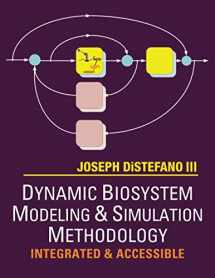
Dynamic Biosystem Modeling & Simulation Methodology - Integrated & Accessible: Enhanced-Education-Color Edition
Book details
Summary
Description
Dynamic Biosystem Modeling & Simulation Methodology: Integrated & Accessible is a uniquely crafted textbook, primarily for use in teaching undergraduates in life sciences, math, computer sciences and engineering.
It’s about learning HOW to model and simulate dynamic biological systems. While it is introductory level, for students who have taken or are currently completing their undergraduate math and introductory science requirements, it’s also useful for graduate students and professional researchers who’d like to explore a more rigorous treatment of introductory life science math modeling integrated with biology.
This new textbook brings together the multidisciplinary pedagogy of these subjects into a single introductory modeling methodology course, crystalizing the experience of an author who has been teaching dynamic biosystems modeling and simulation methodology for the life sciences for more than 50 years. In designing it, his second on the subject, he maximizes accessibility and “systems-math-biology” integration – without diminishing conceptual rigor. Minimally essential applied math and systems engineering methods are included, along with a synopsis of the biology and physiology underlying dynamic biosystem modeling, all in a modeling pedagogy context. It is a selectively filtered, reorganized and integrated version of the subject, accessible to life science sophomores and other entry-level students in bioengineering, computer science, math and other interdisciplinary programs. This book fills a major need in the training of contemporary biology students.
The primary goal of the book is to develop accessible and useful modeling formalisms, first using morphological ideas – form and mechanistic structure. Then it moves on to more abstract modeling paradigms (e.g. block diagrams, directed graphs), and at the same time to the math and computer simulation methods needed to express them quantitatively – a likely first exposure to “explicit and integrated biomodeling” for life science students in particular.
The essence of systems modeling methodology is largely qualitative; and the author has managed to extract this essence, over 12 distinctive chapters, by pruning, rearranging and reorganizing the topics and his approach to teaching them – primarily with simple differential equations and algebra for expressing them quantitatively, integrated with the biology. Solving and analyzing (quantifying) the biomodels are then accomplished by simulation, using a facile simulation language Simulink, a graphical user interface/Matlab toolbox that emulates control systems diagramming, rather than by “coding” the model in a programming language. Students see and work with the system model – not the code – a big plus. Higher math and complex analytical solutions are avoided.
Each chapter begins with a list of LEARNING GOALS, to help with both perspective for the chapter material, and retrospective, to measure learning. EXERCISES for the student at the end of each chapter are designed to test and reinforce learning. A Solutions Manual for chapter exercises is available to qualified instructors from the author, as are Lecture Slides and Lab Assignments & Solutions, for courses that adopt the textbook for student use.
The layout and pacing of the chapters is ideal for undergraduates – with definitions and clear explanations of fundamental terms and concepts, also serving as an essential reference for professional researchers and more advanced students.
This softcover book is available in two versions, a full-color-learning-enhanced edition and a more affordable – but otherwise complete –greyscale edition.


We would LOVE it if you could help us and other readers by reviewing the book
Book review



